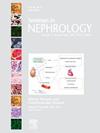Analysis of Serum Creatinine Data from Long-tailed and Rhesus Macaques to Assess Malaria-associated Acute Kidney Injury
IF 3.5
3区 医学
Q2 UROLOGY & NEPHROLOGY
引用次数: 0
Abstract
Malaria caused by the protozoan parasite Plasmodium is associated with vast morbidity and mortality worldwide. Among the serious clinical complications of this disease are acute kidney injury (AKI) and acute kidney disease (AKD), characterized by a decline in kidney function measurable by changes in serum creatinine. Research using nonhuman primates (NHPs) has revealed commonalities between NHPs and humans in malaria pathogenesis. Here, we perform a reanalysis of serum creatinine data from published studies on P. knowlesi malaria infections of long-tailed (natural host) and rhesus (nonnatural host) macaques to assess AKI and AKD. In rhesus macaques, despite receiving antimalarial treatment to reduce parasitemia, delayed onset of AKD occurred days to weeks post-treatment, showing a disconnect between parasitemia and AKD. While the high mortality of rhesus macaques prohibited a prolonged experimental design, the use of long-tailed macaques, naturally resistant to P. knowlesi, enabled longer time series studies and revealed more details about disease progression. Most long-tailed macaques, despite having a natural ability to control parasitemia, also exhibited a delayed onset of AKD in the period following peak parasitemia. Altogether, this study shows that both rhesus and long-tailed macaques exhibit a delayed onset of AKD during malaria, as has been reported in humans.
分析长尾猕猴和恒河猴血清肌酐数据评估疟疾相关急性肾损伤。
由原生动物寄生虫疟原虫引起的疟疾在世界范围内具有很高的发病率和死亡率。该疾病的严重临床并发症包括急性肾损伤(AKI)和急性肾脏疾病(AKD),其特征是通过血清肌酐的变化可测量肾功能下降。利用非人类灵长类动物(NHPs)进行的研究揭示了非人类灵长类动物与人类在疟疾发病机制方面的共性。在这里,我们对已发表的关于长尾(自然宿主)和恒河猴(非自然宿主)诺氏疟原虫疟疾感染的研究中的血清肌酐数据进行了重新分析,以评估AKI和AKD。在恒河猴中,尽管接受了抗疟疾治疗以减少寄生虫病,但AKD的延迟发病发生在治疗后数天至数周,表明寄生虫病与AKD之间存在脱节。虽然恒河猴的高死亡率禁止长期实验设计,但使用对诺氏疟原虫具有天然抗性的长尾猕猴,可以进行更长的时间序列研究,并揭示有关疾病进展的更多细节。大多数长尾猕猴尽管具有控制寄生虫病的天然能力,但在寄生虫病高峰后的一段时间内也表现出AKD的延迟发病。总的来说,这项研究表明恒河猴和长尾猕猴在疟疾期间都表现出延迟发作的AKD,正如在人类中报道的那样。
本文章由计算机程序翻译,如有差异,请以英文原文为准。
求助全文
约1分钟内获得全文
求助全文
来源期刊

Seminars in nephrology
医学-泌尿学与肾脏学
CiteScore
5.60
自引率
0.00%
发文量
27
审稿时长
6-12 weeks
期刊介绍:
Seminars in Nephrology is a timely source for the publication of new concepts and research findings relevant to the clinical practice of nephrology. Each issue is an organized compendium of practical information that serves as a lasting reference for nephrologists, internists and physicians in training.
 求助内容:
求助内容: 应助结果提醒方式:
应助结果提醒方式:


